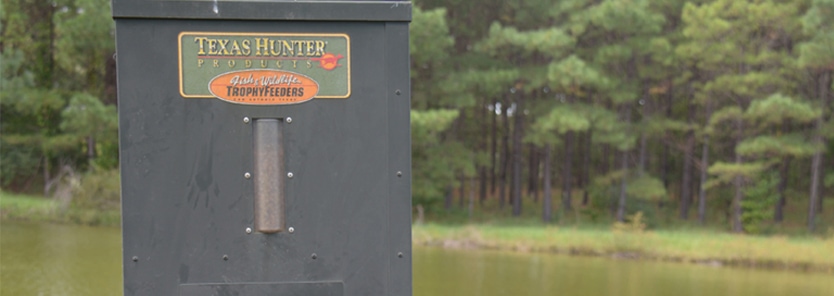How To Winterize Your Automatic Fish Feeder
Although most of us do not think about it, your automatic fish feeder needs a little attention before ignoring it for the winter. There are a couple of options besides completely ignoring your feeder and wondering why it does not work when you fill it with feed during the early spring.
The best option appears to be allowing the feeder to empty itself during the late fall and then setting the timer to run 1-2 seconds daily. This keeps the battery charged, assuming you have a solar panel on the feeder and keeps the motors operating enough to prevent them sticking or freezing up during the winter.
The second option, which may be a good choice if you live in a northern clime where ice and snow could immobilize the feed distribution fan, would be to remove the battery and store on a shelf in a cool, dry place.
So let’s assume you are going to let the feeder run every day for a couple of seconds. There are a couple of extra steps you should take to make sure your feeder is ready to go when the weather warms next spring. First, remove the lid and make sure there are no pellets stuck to the sides of the feeder or around the viewing glass. With moisture during the winter, these pellets will stick together and mold. This will provide a clump of pellets large enough to possibly clog the feed intake when you are ready to use the feeder in the spring. Run the feeder through a test cycle to ensure there are no food pellets in the feed chute or on the fan. Open the bottom compartment and clean out old pellets, debris or fine feed particles that accumulate in the bottom of the feeder throughout the course of operation during the spring and summer. Loosen this buildup and use a hand vacuum to remove then finish cleaning with a damp cloth. Service the battery and leads by applying a grease designed to prevent battery corrosion (you can find a small tube of this at the counter of almost any auto parts store). Once all of these steps are completed, use a hasp or carabineer to fasten each of the compartment doors and the lid. You will be ready for next spring!
Mr. Chris Blood of Texas Hunter Feeders encourages owners to run their feeders daily even if they are not feeding during the winter. “Daily operation keeps a full charge on the battery and ensures both motors continue to run smoothly,” says Blood. “Our batteries will normally last two or more years if you keep them charged and can withstand very cold winter temperatures without damage. Our feeder bodies are designed to withstand the rigors of the outdoors and do not need to be stored inside,” states Blood.
If the battery is removed from the feeder during the winter, make sure it is placed on a trickle charger to restore full power before attempting to operate the following spring, usually 24 hours is adequate. Make sure the pellet distribution fan is turning smoothly by using a stick instead of your finger to turn the fan blades before you connect the battery. You never know what could be hiding behind that fan!
Remember to run a test cycle before you fill the feeder with fish feed. If all works well, fill your feeder and begin a feeding program for you hungry fish!
~
For more from GameKeeper Farming For Wildlife, join our weekly newsletter or subscribe to GameKeepers Magazine. Your source for information, equipment, know-how, deals and discounts to help you get the most from every hard-earned moment in the field.





